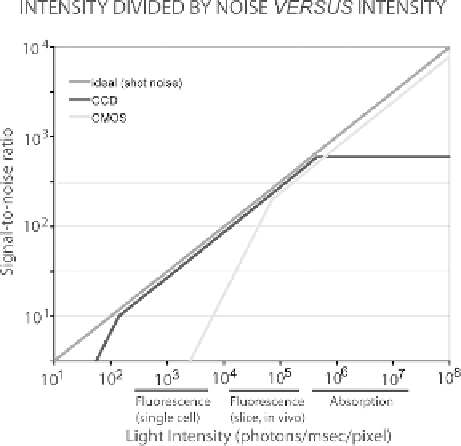Biomedical Engineering Reference
In-Depth Information
Fig. 3.11. The ratio of light intensity divided by the noise in the measurement as a func-
tion of light intensity in photons/ms/pixel. The theoretical optimum signal-to-noise ratio
(medium line) is the shot-noise limit. Two camera systems are shown, a 10 kHz frame
rate, 128×128 pixel, CMOS camera and a back-illuminated, 2 kHz frame rate, 80×80
pixel, CCD camera. The CMOS camera (light line) provides a near optimal signal-to-
noise ratio at higher light intensities while the CCD camera (dark line) is better at lower
intensities. The approximate light intensity per detector in fluorescence measurements
from a single neuron, fluorescence measurements from a slice or in vivo preparation,
and in absorption measurements from a ganglion or a slice is indicated along the x
axis. The signal-to-noise ratio for the CMOS camera falls away from the ideal at low
intensities because of dark noise. The lower dark noise of the cooled CCD allows it to
function at the shot-noise limit at lower intensities until read noise dominates at about
10
2
photons/pixel/msec. The CCD camera saturates at intensities above 5×10
5
pho-
tons/ms/pixel.
objective numerical apertures, about 10
13
photons/ms will reach
the image plane. (In a fluorescence measurement, there will be
much less light measured because 1. only a fraction of the inci-
dent photons are absorbed by the fluorophores, 2. only a fraction
of the absorbed photons appear as emitted photons, and 3. only a
fraction of the emitted photons are collected by the objective.) If
the camera has a quantum efficiency of 1.0, then, in absorption, a
total of 10
13
photoelectrons/ms will be measured. With a camera
of 10,000 pixels, there will be 10
9
photoelectrons/ms/pixel. The
shot noise will be 10
4.5
photoelectrons/ms/pixel; thus, the very
best that can be expected is a noise that is 10
−
4.5
of the resting
light (a signal-to-noise ratio of
90 db). The extra light losses in
a fluorescence measurement would further reduce the maximum
obtainable signal-to-noise ratio.
One way to compare the performance of different camera
systems for wide-field imaging and to understand their devia-
tions from optimal (shot-noise limited) is to determine the light
∼

